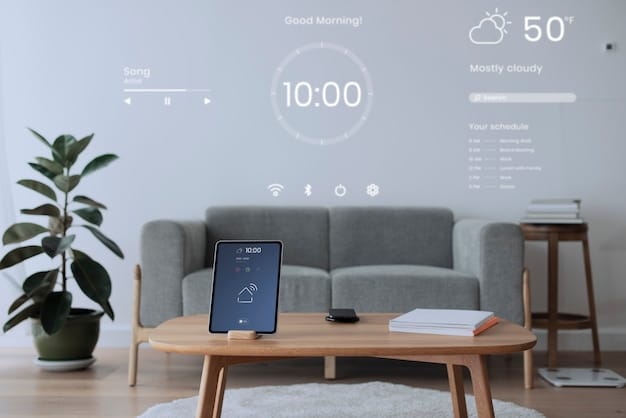Future of Smart Home Technology: Predictions for 2030 & Beyond

Anúncios
The future of smart home technology promises unparalleled levels of automation, personalization, and sustainability, transforming our living spaces into intelligent ecosystems driven by advanced AI, enhanced connectivity protocols, and a deeper integration with our daily lives by 2030 and beyond.
The dawn of truly intelligent living spaces is upon us. As we look towards 2030 and beyond, the future of smart home technology: predictions for 2030 and beyond paints a picture of homes that are not merely connected, but inherently intuitive. This evolution promises to reshape our daily interactions with our environments, blending seamless automation with hyper-personalization.
The Rise of Hyper-Personalized AI Assistants
In the coming decade, smart home assistants will transcend simple voice commands, evolving into sophisticated AI companions deeply attuned to individual preferences and routines. Imagine an assistant that anticipates your needs before you vocalize them, subtly adjusting your environment for optimal comfort and productivity.
This goes beyond merely turning on lights; it involves a profound understanding of biometric data, emotional states, and even long-term habits. Such an AI would be capable of creating a truly responsive living space, adapting in real-time to your presence and activities throughout the day.
Predictive Personalization and Environmental Adaptation
Future AI assistants will leverage advanced machine learning to predict user behavior with uncanny accuracy. This means your home will pre-emptively adjust lighting, temperature, and even music based on your historical patterns, current mood, and external factors like weather. The goal is to minimize manual intervention, making the smart home truly invisible in its operation.
- Proactive climate control based on forecasted weather and personal preferences.
- Dynamic lighting scenes that adapt throughout the day, mimicking natural light cycles.
- Anticipatory entertainment systems, suggesting content based on your historical viewing and listening habits.
Furthermore, these systems will learn and refine their understanding of your preferences over time, becoming increasingly accurate and efficient. The era of generic “smart” settings will be replaced by bespoke environmental profiles for every occupant, accessible seamlessly across different rooms and even different residences.
Enhanced Security and Privacy Measures
As AI assistants become more integrated into our private lives, the importance of robust security and privacy protocols will be paramount. Expect advanced encryption, decentralized data storage, and user-centric control over personal information. Transparency in data usage will be a key differentiator for leading smart home platforms.
Biometric authentication, such as facial recognition and voiceprint analysis, will not only secure your home but also personalize experiences. This ensures that environmental adjustments are made only for authorized individuals, enhancing both security and personalized comfort.
The hyper-personalized AI assistants of the future will represent a significant leap from current iterations. They will move from being reactive tools to proactive partners in managing our domestic environments, learning our specific rhythms and adapting our spaces accordingly. This shift promises unprecedented levels of comfort and efficiency, making our homes deeply responsive extensions of ourselves.
Seamless Connectivity and Interoperability Standards
The smart home landscape of today is often fragmented, with devices from different manufacturers struggling to communicate effectively. By 2030, this fragmentation will largely be a thing of the past. Robust, universal interoperability standards will ensure that every smart device, regardless of brand, can communicate and cooperate seamlessly.
This evolution is crucial for unlocking the full potential of smart homes, moving beyond isolated functionalities to truly integrated ecosystems. Imagine a home where your smart TV can tell your smart blinds to close when you start a movie, and your smart thermostat knows to pre-condition the air when your autonomous vehicle is five minutes from home.

The Dominance of Unified Protocols (e.g., Matter)
Ongoing efforts like the Matter connectivity standard are paving the way for this unified future. These protocols aim to simplify adoption for consumers and developers alike, ensuring cross-platform compatibility. This means less troubleshooting for users and more focus on innovative new features from manufacturers.
- Simplified setup and device pairing processes.
- Improved reliability and responsiveness of interconnected devices.
- Wider choice of compatible products from various brands.
The convergence on a few dominant, open-source protocols will foster greater competition and innovation in the smart home market. Consumers will benefit from more choices, better product quality, and a truly integrated smart home experience that feels effortless.
Edge Computing and Enhanced Responsiveness
Much of the processing power for smart home systems will shift from cloud-based servers to the devices themselves, enabled by advancements in edge computing. This reduces latency, improves privacy, and ensures faster response times, even during internet outages.
Local processing minimizes the need for constant data transfer to the cloud, significantly enhancing reliability and privacy. Your smart home will become a self-sufficient ecosystem, capable of performing complex tasks independently and more securely.
The widespread adoption of universal standards and the proliferation of edge computing will fundamentally transform the smart home experience. It will transition from a collection of disparate gadgets to a cohesive, intelligent environment where devices work together harmoniously, providing a truly seamless and responsive living experience.
Sustainable Smart Living and Energy Management
As global environmental concerns intensify, smart homes will play a pivotal role in promoting sustainability and reducing energy consumption. Future smart homes will not only monitor energy use but actively optimize it, leveraging renewable sources and intelligent grid integration.
This includes sophisticated energy management systems that learn consumption patterns, predict peak demand, and dynamically adjust appliance usage to minimize waste and cost. The emphasis will be on creating eco-conscious living spaces that benefit both the planet and the homeowner’s wallet.
Dynamic Energy Optimization and Renewable Integration
Smart homes will seamlessly integrate with solar panels, battery storage systems, and even electric vehicles (EVs), forming a micro-grid within the property. Energy management systems will intelligently decide when to draw power from the grid, residential solar, or stored battery power, based on real-time energy prices and predicted usage.
- Automated load shedding during peak energy times.
- Optimized charging of EVs using excess solar energy or off-peak grid power.
- Integration with smart grids for demand response programs, earning homeowners credits.
These systems will empower homeowners to become active participants in a more sustainable energy ecosystem, promoting energy independence and resilience. The ability to monitor, manage, and even sell excess energy back to the grid will become standard.
Water Management and Waste Reduction
Beyond energy, smart homes will extend their sustainability efforts to water management and waste reduction. Leak detection systems will become standard, preventing costly damage and conserving precious resources. Smart irrigation systems will use hyper-local weather data to water gardens optimally, minimizing waste.
Intelligent waste sorting and composting solutions will also emerge, simplifying recycling efforts for residents. RFID-tagged bins might even communicate with automated collection systems, further streamlining waste management processes.
The future of smart homes is deeply intertwined with sustainability. By integrating intelligent energy management, renewable energy sources, and efficient resource utilization, these homes will not only offer convenience but also contribute significantly to a greener planet, making eco-friendly living effortless and intuitive.
Advanced Health, Wellness, and Security Integration
Smart homes will evolve beyond comfort and convenience, becoming proactive hubs for health, wellness, and security. Integrated sensors and AI will continuously monitor environmental factors and even resident biometrics, providing personalized insights and emergency response capabilities.
This integration aims to create environments that actively promote well-being and provide peace of mind, especially for elderly residents or those with specific health needs. The home will become a silent guardian, ensuring safety and optimizing conditions for a healthy lifestyle.
Environmental Health Monitoring
Beyond basic air quality sensors, future smart homes will feature comprehensive environmental monitoring that checks for allergens, pollutants, mold, and even certain airborne pathogens. Systems will automatically activate air purification or ventilation when anomalies are detected, maintaining optimal indoor air quality.
Sleep patterns will be monitored non-invasively through smart beds or room sensors, with AI offering personalized recommendations for better rest. Lighting systems will adjust circadian rhythms, promoting healthier sleep-wake cycles.
Proactive Security and Emergency Response
Next-generation security systems will combine advanced facial recognition, gait analysis, and predictive analytics to identify potential threats before they materialize. Drones for perimeter surveillance and AI-powered access control will be common features, offering unparalleled protection.
- Automated detection of unusual activity and immediate alerts to homeowners/authorities.
- Integration with emergency services for rapid response to medical emergencies or intrusions.
- Non-invasive fall detection for elderly residents, providing alerts to caregivers.
These systems will learn the normal patterns of household activity, quickly flagging any deviations as potential security risks. The focus shifts from reactive alarms to proactive threat neutralization, leveraging a network of smart sensors and AI to provide a comprehensive security blanket.
The integration of advanced health, wellness, and security features will transform smart homes into truly holistic living environments. They will not only adapt to our preferences but actively safeguard our well-being and provide an unprecedented level of security, making our homes sanctuaries of health and safety.
Augmented Reality and Immersive Interfaces
Forget touchscreens and voice commands—the future of smart home interaction lies heavily in augmented reality (AR) and immersive interfaces. Imagine controlling your home by gesturing in the air, or seeing real-time data overlays on your walls and furniture through smart glasses or projection technology.
This shift will make interacting with your home more intuitive and seamless, blurring the lines between the digital and physical worlds. The home itself will become the interface, dynamically adapting to your needs and preferences through visual and spatial interactions.
Spatial Computing and Gesture Control
With AR, spatial computing will allow users to interact with their smart home visually, manipulating virtual controls overlaid on physical objects. A glance at a window might bring up virtual blinds controls, or a wave of the hand could adjust room temperature.
- Projected interfaces on any surface, turning walls into interactive displays.
- Hands-free control through highly sensitive gesture recognition.
- Personalized holographic assistants that appear only to the user wearing AR devices.
This means less reliance on physical screens and a more natural, human-centric way of managing your environment. The smart home will fade into the background, providing its services without demanding constant attention to a separate device.
Immersive Entertainment and Remote Presence
AR will also revolutionize home entertainment, creating truly immersive experiences. Walls could transform into vast cinematic screens, or virtual worlds could be projected into your living room, allowing for unparalleled gaming or virtual travel experiences.
Furthermore, AR will facilitate enhanced remote presence, blurring the lines between physical and virtual meetings. Holographic projections of faraway family members or colleagues could appear in your living room, making remote interactions feel more personal and immediate.
The advent of augmented reality and immersive interfaces will redefine how we interact with our smart homes. It promises a future where control is intuitive, entertainment is boundless, and human connection, even across distances, feels more tangible, transforming our passive living spaces into dynamic, interactive environments.
Autonomous Robotics and Domestic Automation
By 2030, autonomous robotics will be an integral part of the smart home, moving beyond simple robot vacuums to sophisticated domestic assistants capable of a wide range of tasks. These robots will seamlessly integrate into the home environment, learning layouts, anticipating needs, and performing chores with minimal human intervention.
This evolution will free up significant human time, allowing residents to focus on higher-value activities or simply enjoy leisure. The home will not just be smart, but actively managed and maintained by advanced robotic companions.

Multi-functional Domestic Robots
Expect general-purpose domestic robots capable of tasks like cleaning, organizing, and even simple meal preparation. These robots will navigate complex home environments, understanding household objects and adapting to changing conditions.
- Automated sorting and cleaning of dishes, laundry, and other household items.
- Delivery of items within the home, from bringing a beverage to fetching misplaced glasses.
- Assistance with elder care, including medication reminders and mobility support.
These robots will be equipped with advanced sensors and AI, allowing them to learn and improve their performance over time. They will understand verbal commands and even anticipate tasks based on learned routines and environmental cues.
Integrating Robotics with Smart Home Ecosystems
The key to their utility will be deep integration with the existing smart home ecosystem. Robots will communicate with smart appliances, security systems, and AI assistants to coordinate tasks efficiently. For instance, a robot might charge its battery during off-peak energy hours or alert you if it detects a leak while cleaning.
This seamless interoperability means the robots aren’t just isolated machines but active members of the smart home, contributing to its overall efficiency and autonomy. They will be designed to be unobtrusive and intuitive, complementing human activity rather than replacing it.
Autonomous robotics will fundamentally change the nature of domestic chores, offering unparalleled convenience and efficiency. The smart home of the future will be a living space where mundane tasks are handled deftly by robotic companions, allowing occupants to enjoy a higher quality of life and reclaim valuable time.
Ethical Considerations and Societal Impact
As smart home technology advances, so too do the ethical considerations surrounding data privacy, algorithmic bias, and the potential impact on human autonomy and societal structures. Addressing these challenges proactively will be crucial for ensuring a positive and equitable future for smart living.
The push for widespread adoption must be balanced with robust ethical frameworks and regulatory oversight to protect consumer rights and prevent misuse of powerful technologies. Transparency and user control over data will be central to building trust.
Data Privacy and Algorithmic Bias
The sheer volume of personal data collected by smart homes—from routines to biometrics—raises significant privacy concerns. Strong regulations, akin to GDPR, will be necessary to ensure data is collected, stored, and used responsibly. Decentralized data storage and end-to-end encryption will become standard.
- Strict consent mechanisms for data collection and sharing.
- Independent audits of algorithms to prevent discriminatory or biased outcomes.
- User-friendly dashboards for monitoring and managing personal data.
Furthermore, the algorithms powering smart home AI must be carefully developed to avoid inherent biases that could lead to unfair or inequitable outcomes. Ensuring diverse development teams and rigorous testing will be vital.
Impact on Human Autonomy and Social Interaction
While automation offers convenience, there is a legitimate concern about over-reliance on smart systems potentially diminishing human agency or social interaction. Designing smart homes that augment human capabilities rather than replace them will be a key challenge.
The future smart home should provide choices, allowing users to opt-in or out of various automated functions. It should foster human connection and well-being, avoiding the creation of isolated or overly controlled environments.
Navigating the ethical landscape of advancing smart home technology requires careful foresight and collaborative efforts from technologists, policymakers, and consumers. By prioritizing privacy, fairness, and human well-being, we can ensure that the smart homes of 2030 and beyond truly enhance our lives in a responsible and sustainable manner.
| Key Prediction | Brief Description |
|---|---|
| 🤖 Hyper-Personalized AI | AI assistants will anticipate needs, adapting environments based on individual habits and biometrics. |
| 🔗 Seamless Interoperability | Universal standards like Matter will ensure all devices communicate flawlessly, ending fragmentation. |
| 🌿 Sustainable Living | Homes will actively optimize energy use, integrate renewables, and manage water/waste intelligently. |
| ✨ AR & Immersive Interfaces | Control homes via gestures and see data overlays through AR, blurring digital and physical. |
Frequently Asked Questions About the Future Smart Home
By 2030, AI will use advanced machine learning to predict your habits, preferences, and even emotional states. It will proactively adjust lighting, temperature, music, and security settings to create an optimal environment without explicit commands. This includes adapting to your sleep patterns, biometric data, and anticipating your needs throughout the day for unparalleled comfort.
Yes, significant progress is being made towards universal interoperability. Standards like Matter aim to ensure that devices from various manufacturers can communicate and operate together effortlessly. This will reduce fragmentation, simplify setup, and allow consumers to choose products based on features rather than compatibility, leading to a truly integrated home ecosystem.
Future smart homes will feature dynamic energy management systems. They will integrate with solar panels, EV chargers, and smart grids to optimize energy consumption, leveraging renewable sources and adjusting usage based on real-time prices. Beyond energy, these homes will also manage water usage intelligently and simplify waste sorting, promoting overall eco-friendly living.
Augmented reality (AR) will transform how we interact with our homes. Instead of screens, you might use gestures to control devices, with virtual interfaces layered onto physical objects via smart glasses or projections. This will create a more intuitive, immersive experience, blurring the lines between the digital and physical, and making control feel more natural and seamless.
Quite likely. By 2030, autonomous internal robots are predicted to move beyond basic vacuums, performing a wider range of household tasks like cleaning, organizing, and even assisting with daily chores. These robots will integrate deeply with your smart home ecosystem, sharing data and coordinating actions to maintain your living space efficiently and with minimal human intervention.
Conclusion
The trajectory of smart home technology towards 2030 and beyond points to a future where our living spaces are not just smart, but truly intelligent, personalized, and environmentally conscious. From hyper-personalized AI assistants anticipating our every need to autonomous robots managing domestic tasks, and immersive interfaces transforming our interactions, the home will evolve into a dynamic, responsive ecosystem. Addressing ethical considerations around privacy and algorithmic bias will be paramount to ensuring these advancements genuinely enhance our lives, fostering environments that are safe, sustainable, and deeply attuned to human well-being. The vision is clear: homes will become active partners in our daily lives, making comfort, efficiency, and sustainability effortless.





